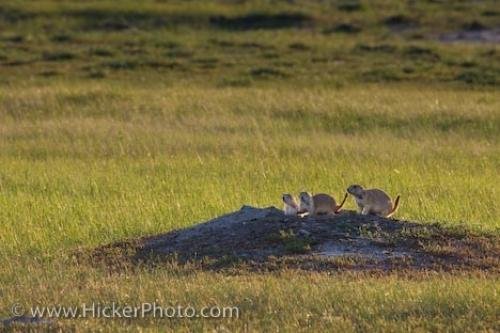Photo: Black Tailed Prairie Dogs Grasslands National Park Saskatchewan
A playful and sociable species of animal, black-tailed prairie dogs can only be found roaming wild in and around the Grasslands National Park of Saskatchewan, Canada.
Although prairie dogs are seen as competitors with cattle for food and for being a danger to livestock, they are a critical link in keeping the delicate balance of nature, in fact the black-tailed prairie dog is a key component of the Grasslands National Park ecosystem. The health and success of the black-tailed prairie dog is crucial for the survival of many other wildlife species such as coyotes, fox, badger, ferruginous hawks, and burrowing owls, prairie rattlesnakes, short horned lizards, and the black-footed ferret.
The natural land features which define the borders of these social animals are tall grasses, rocky ground, creeks or bush. There are approximately 25 prairie dog towns or colonies in and around Grasslands National Park in Saskatchewan, Canada with the first one discovered near the village of Val Marie in the 1920's. ... continue below the picture...
Black Tailed Prairie Dogs Grasslands National Park Saskatchewan

Pictures from photo gallery "Wild Animal Pictures"
This picture is part of the photo album "Animal Pictures" - there are more beautiful images waiting for you.
Related stock photo galleries, pictures & travel ideas:
Black Tailed Prairie Dogs Grasslands National Park Saskatchewan
... Some of the colonies range in size from .55 to 172 hectares in size.
The burrows of the black-tailed prairie dogs are passed down through the generations. Shortly after the newborn animals have appeared above ground with their parents, the parents abandon their burrow to their young, while they establish a new burrow.
Black-tailed Prairie Dogs, Cynomys ludovicianus, in Dog Town along the Frenchman River Valley Ecotour Route in the West Block of Grasslands National Park, Saskatchewan, Canada.
Technical Information:
I photographed this photo with the digital SLR camera model Canon EOS-1Ds Mark III, aperture of f/9.0, exposure time of 1/80 sec. on ISO 100, as always I used a original Canon Lens, the focus lenght for this picture was 400mm.
A playful and sociable species of animal, black-tailed prairie dogs can only be found roaming wild in and around the Grasslands National Park of Saskatchewan, Canada.
